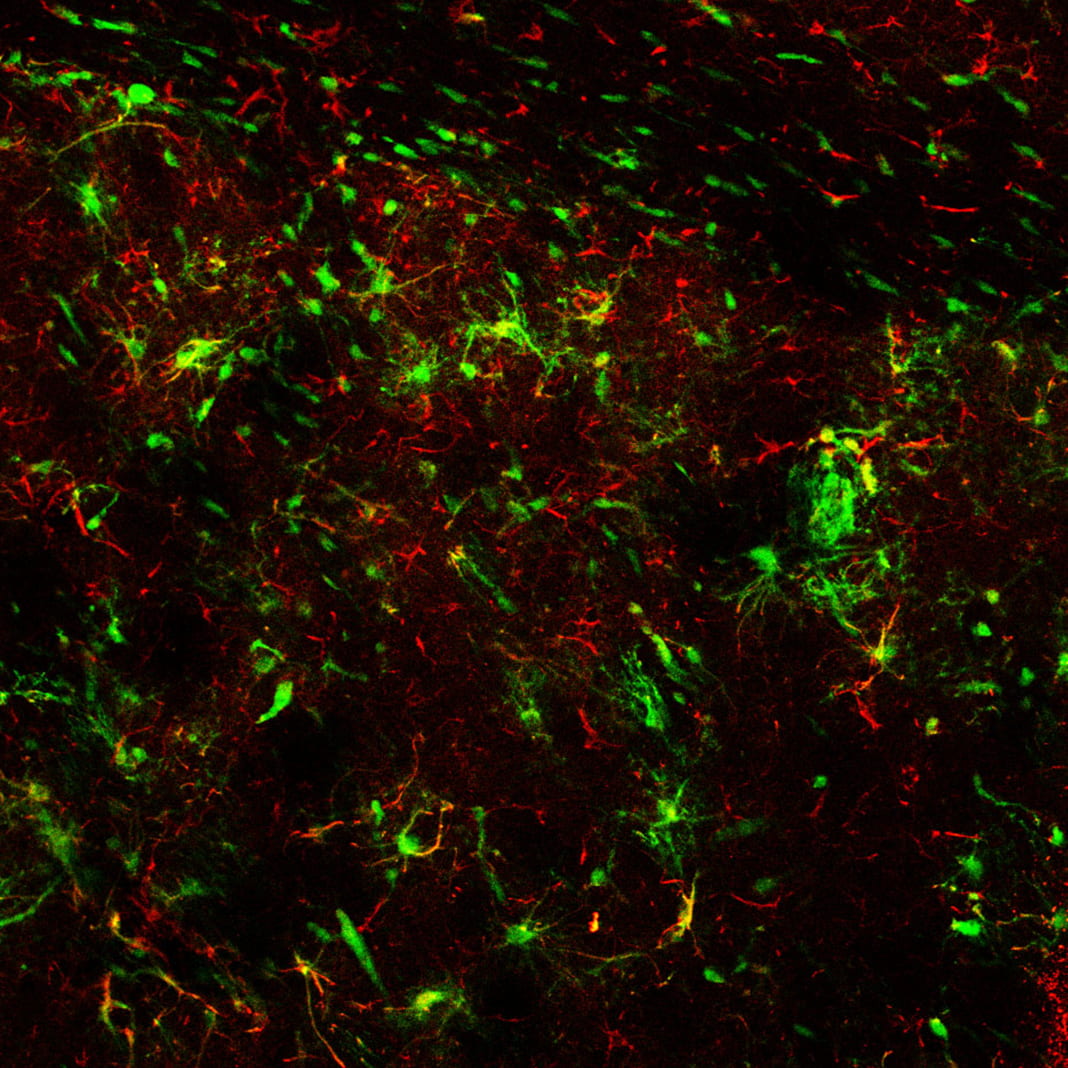Stem cell treatment lessens impairments caused by dementia with Lewy bodies
UCI mouse study finds significant improvements in both motor and cognitive function

Irvine, Calif., Oct. 15, 2015 — Neural stem cells transplanted into damaged brain sites in mice dramatically improved both motor and cognitive impairments associated with dementia with Lewy bodies, according to University of California, Irvine neurobiologists with the Sue & Bill Gross Stem Cell Research Center and the Institute for Memory Impairments and Neurological Disorders.
DLB is the second-most common type of age-related dementia after Alzheimer’s disease and is characterized by the accumulation of a protein called alpha-synuclein that collects into spherical masses called Lewy bodies – which also accumulate in related disorders, including Parkinson’s disease. This pathology, in turn, impairs the normal function of neurons, leading to alterations in critical brain chemicals and neuronal communication and, eventually, to cell death.
The UCI researchers, led by associate professor of neurobiology & behavior Mathew Blurton-Jones and doctoral student Natalie Goldberg, hope that one day transplantation of neural stem cells into human patients might help overcome the motor and cognitive impairments of DLB.
Study results appear online in Stem Cell Reports.
To test their idea, the researchers transplanted mouse neural stem cells into genetically modified mice exhibiting many of the key features of DLB. One month later, the mice were retested on a variety of behavioral tasks, and significant gains in both motor and cognitive function were observed. For example, these mice could run on a rotating rod for much longer and recognize novel objects far better than untreated DLB mice.
To understand how stem cell transplantation alleviated impairments, Goldberg and colleagues examined the effects of the stem cells on brain pathology and circuitry connecting neurons. They found that functional improvements required the production of a specific growth factor – called brain-derived neurotrophic factor – by neural stem cells.
The team examined two of the key brain structures that become dysfunctional in DLB – dopamine- and glutamate-making neurons – to determine how BDNF might drive recovery. “Our experiments revealed that neural stem cells can enhance the function of both dopamine-and glutamate-producing neurons, coaxing the brain cells to connect and communicate more appropriately. This, in turn, facilitates the recovery of both motor and cognitive function,” Goldberg said.
To further confirm the importance of BDNF in these effects, the researchers modified the stem cells so that they could no longer produce the growth factor. When these modified cells were transplanted, they failed to improve behavioral function and no longer enhanced dopamine and glutamate signaling.
Testing the possibility that BDNF alone might be an effective treatment, Goldberg used a virus to deliver the growth factor to the brains of DLB mice.
She found that this treatment resulted in good recovery of motor skills in the test rodents but only limited recovery of cognitive function. This, Goldberg said, suggests that while BDNF is critical to stem cell-mediated motor and cognitive recovery, it does not achieve this outcome alone.
These results imply that transplantation of BDNF-producing neural stem cells may one day offer a new approach for treating DLB, and Blurton-Jones and Goldberg are cautiously optimistic.
“Many important questions remain before we could envision moving forward with early-stage trials,” Blurton-Jones said. “For example, we’ll need to identify and test human neural stem cells first.”
Nevertheless, if this approach holds up, BDNF-producing neural stem cells might also be beneficial for several other diseases. “BDNF, dopamine and glutamate are implicated in other neurodegenerative conditions, including Huntington’s and Alzheimer’s disease,” Goldberg noted.
Jacqueline Caesar, Ashley Park, Shawn Sedgh, Gilana Finogenov and Joy Davis of UCI as well as Eliezer Masliah of UC San Diego contributed to the study, which received support from the National Science Foundation.
About the University of California, Irvine: Currently celebrating its 50th anniversary, UCI is the youngest member of the prestigious Association of American Universities. The campus has produced three Nobel laureates and is known for its academic achievement, premier research, innovation and anteater mascot. Led by Chancellor Howard Gillman, UCI has more than 30,000 students and offers 192 degree programs. It’s located in one of the world’s safest and most economically vibrant communities and is Orange County’s second-largest employer, contributing $4.8 billion annually to the local economy. For more on UCI, visit www.uci.edu.
Media access: Radio programs/stations may, for a fee, use an on-campus ISDN line to interview UC Irvine faculty and experts, subject to availability and university approval. For more UC Irvine news, visit wp.communications.uci.edu. Additional resources for journalists may be found at communications.uci.edu/for-journalists.